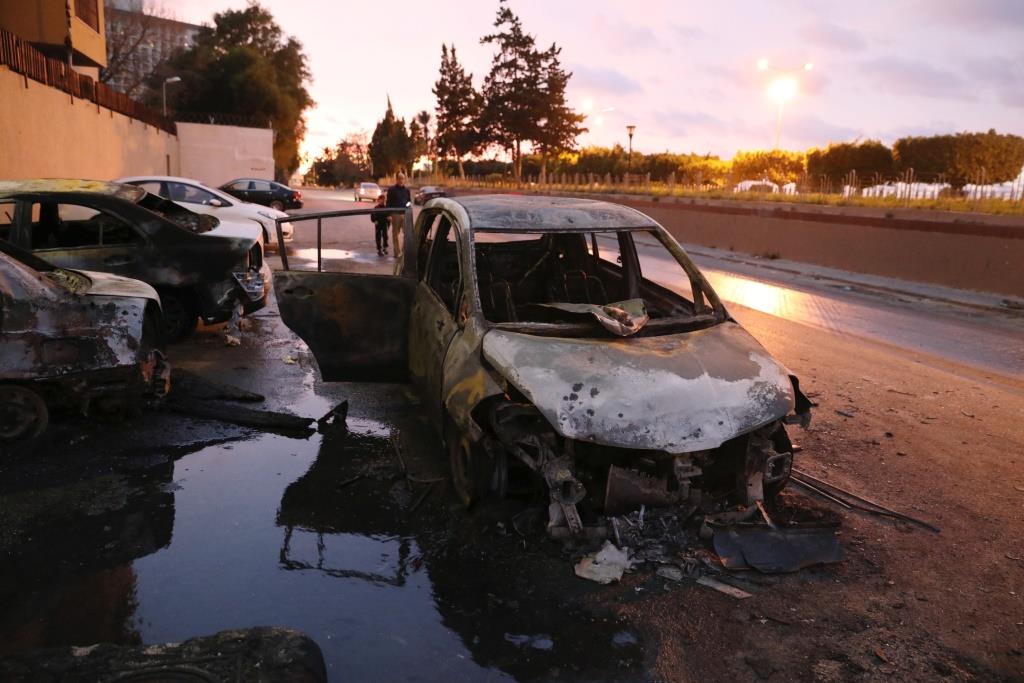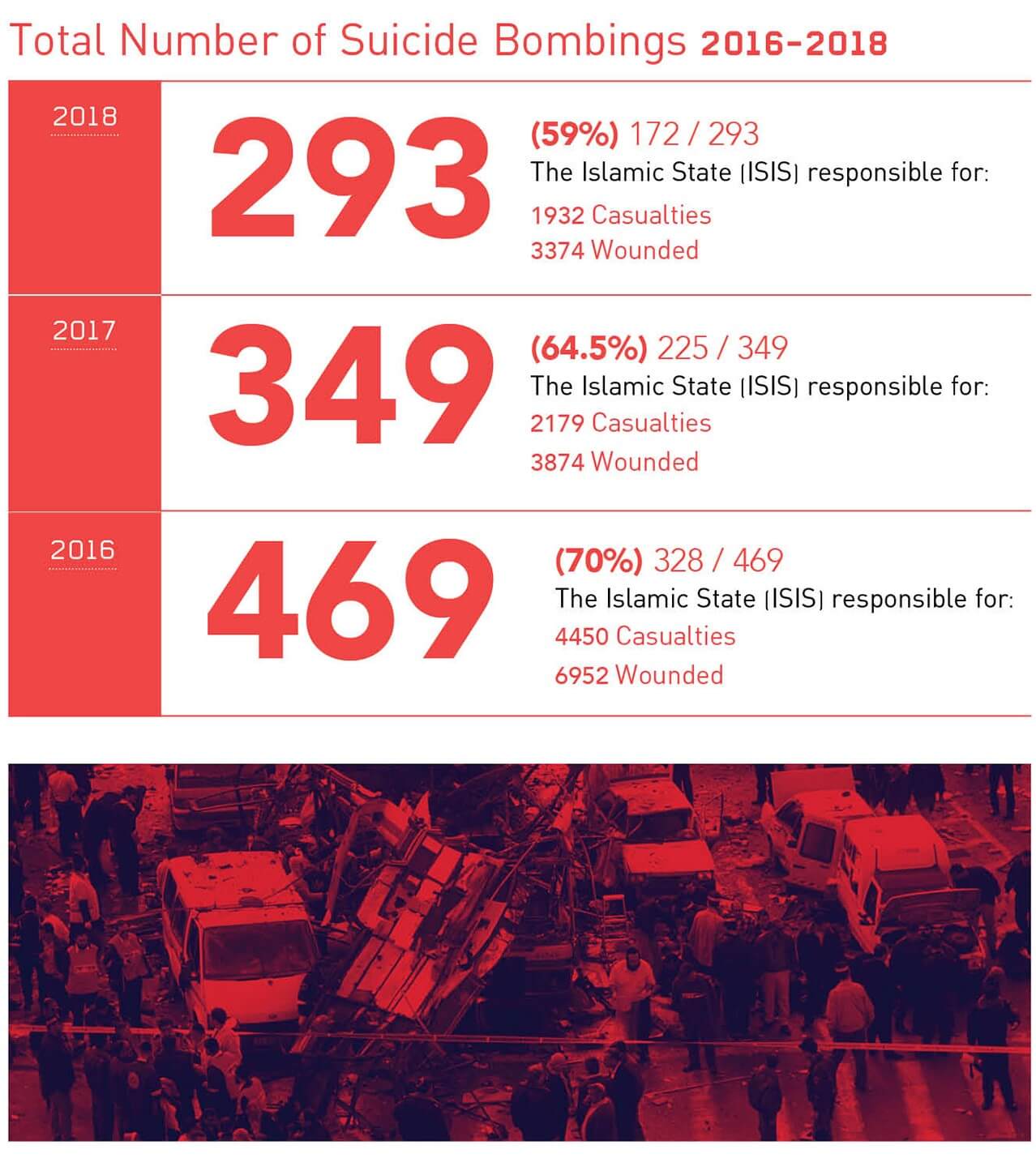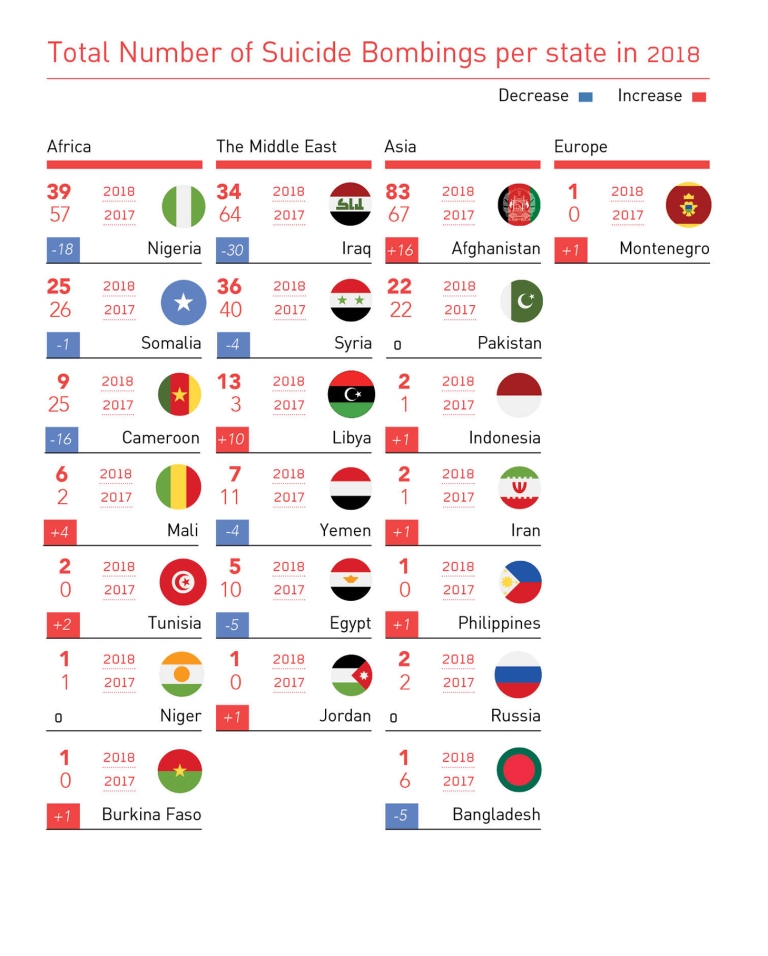Publications
INSS Insight No. 1126, January 7, 2019

2018 saw the continued perpetration of suicide attacks by global terror organizations, although for the third consecutive year, there was a decline in the number of suicide attacks committed in the world, and a decline in the number of people killed. Although the Middle East was still a frequent site of suicide attacks, for the first year Asia had the highest number of attacks, most of which were carried out in Afghanistan. Notwithstanding the Islamic State’s military defeat and loss of control over large areas in the Middle East, the organization was once again the primary perpetrator of suicide attacks around the world. More generally, it is estimated that about 98 percent of all suicide bombings are linked with the Salafi jihadist camp, carried out by the Islamic State, al-Qaeda, and other organizations. The immense damage and high death toll caused by suicide terrorism make it a highly lethal and effective tool for global terror organizations, and therefore it is likely they will continue to use this form of attack as the preferred weapon of choice.
Suicide bombings remain one of the most effective tools in the hands of terror organizations, making these groups appear much stronger than they are in reality and enabling them to run an effective campaign of intimidation against their enemies. The strong impact of this form of terror stems from the shock it causes and the large number of casualties it inflicts, which exceed the effect of other forms of attack used by these organizations. In addition, the decision by some organizations to carry out suicide attacks stems from social, cultural, religious, and political contexts.
Modern age suicide attacks became prominent in the early 1980s in Lebanon, and from there spread to other parts of the world. Since the start of the millennium their number has increased exponentially. US military involvement in Iraq and Afghanistan following the September 11, 2001 attacks opened a Pandora’s Box in these states, which have since become a main site of suicide bombings. With time, however, Western targets in these states were pursued less, and the attacks were used primarily as a tool in internal conflicts against local enemies based on political, ethnic, and religious disputes.
Each year, the Terrorism and Low Intensity Conflict Research Program at the Institute for National Security Studies (INSS) publishes statistics on suicide bombings committed during the calendar year and analyzes their trends. In recent years it has become more difficult to follow these forms of attacks, particularly in high intensity combat zones such as Iraq and Syria, where suicide bombers were integrated into standard warfare practices of the Islamic State. The Islamic State published data that was unconfirmed by independent sources, and media coverage in conflict areas was lacking.
According to data collected by the INSS program, which relies on at least two independent sources (combined attacks in near proximity are counted as one), in 2018 about 293 suicide attacks were committed by about 505 perpetrators, of whom about 84 were women. In these attacks approximately 2,845 people were killed and 5,160 injured. This data illustrate a continued downward trend in the number of suicide attacks over the past three years. In 2018 there was a decline of about 16 percent over the preceding year, and most of the attacks occurred in Southeast Asia (mainly in Afghanistan and Pakistan), in the Middle East (mainly in Syria and Iraq), and in Africa (mainly in Nigeria and Somalia). In 2018, suicide attacks took place in 21 countries, compared with 23 last year.


In 2018, and despite the decline in activity, the Islamic State was once again the primary perpetrator of suicide attacks around the world. Notwithstanding its military defeat and loss of control over large areas in the Middle East, the Islamic State and its partners were still directly and indirectly responsible for about 172 suicide attacks, which amount to about 59 percent of all attacks. In comparison, in 2017 the Islamic State and its partners were directly and indirectly responsible for about 190 attacks. Al-Qaeda and its affiliates worked alongside the Islamic State and its affiliates - at once partners and competitors for leadership of the global jihad from the Salafi jihadist camp - and were responsible for about 67 attacks, or approximately 23 percent of all suicide attacks. Accordingly, organizations aligned with this ideology were responsible for about 80 percent of all attacks. Furthermore, 45 of the additional attacks (which amount to approximately 15 percent) were committed by perpetrators not known to be affiliated with a particular organization, but it is highly likely that they were also perpetrated by elements associated with the Salafi jihadist ideology because they took place in areas where this camp and its ideology are dominant. If so, then about 98 percent of all suicide bombings are linked with this stream.
Contrary to the Middle East’s continued role in past years as the leading area for suicide bombings (mainly in Iraq), in 2018, Asia, particularly Afghanistan, became the primary zone. In Asia there were a total of about 113 suicide attacks, or about 38.5 percent of all attacks. This number is almost identical to the number of attacks last year (112 attacks, approximately 32 percent). In Afghanistan there were approximately 83 suicide attacks in 2018, an increase of about 24 percent over the previous year. The Islamic State was the dominant player in Afghanistan’s Khorasan region this year, where it perpetrated about 35 attacks, compared with the Taliban, which were responsible for about 25 attacks. This is a significant change, since traditionally the Taliban were the dominant force using such methods. In Pakistan there were about 22 suicide attacks this year (the same as 2017). Additional attacks took place in Indonesia, Russia, and the Caucasus, and in Iran, with two in each country, and one in the Philippines, the first in many years.
At the same time, the Middle East remained a central region of activity: this year it saw about 97 suicide attacks, amounting to approximately 33 percent of all attacks. This is a decrease of about 27.5 percent over the previous year. The greatest number of attacks took place in Syria – about 36, in connection with the raging civil war and in the campaign to rid the country of the Islamic State. In Iraq there were approximately 34 suicide attacks – a decrease of about 35 percent over last year, and all perpetrated by the Islamic State. In comparison, Libya saw an increase in the number of suicide attacks. In 2018 there were about 13 attacks there, nine of which were perpetrated by the Islamic State. Additional attacks in the Middle East took place in Yemen (7), Egypt (5), Tunisia, and Jordan (1 in each).
The third primary zone is Africa: in 2018 there were approximately 82 suicide attacks, which amounted to about 28 percent of all suicide terrorism. Africa too saw a decrease of about 26.5 percent compared with the prior year. The greatest number of attacks took place in Nigeria – approximately 39, and in Somalia – approximately 25 attacks. Similar to Asia, Africa is as an area of competition for hegemony and expansion on the continent between proxy organizations of the Islamic State, led by Boko Haram, which is mainly active in Nigeria as well as in Chad and Niger, and al-Shabaab, which is primarily active in Somalia and Kenya. These organizations committed the vast majority of suicide attacks in the continent. Additional attacks took place in Cameroon (9), Mali (6), Niger, and Burkina Faso (1 in each).
2018 also saw participation by women in suicide attacks, but contrary to 2017, there has been a significant decrease in their number. This year about 84 women participated in 38 suicide attacks in eight countries. In these attacks about 158 people were killed and about 514 injured. This represents a decline when compared with the previous year – when about 137 women participated in about 61 attacks. Most female suicide bombers were sent by Boko Haram, which was responsible for dispatching about 74 women to about 31 attacks – most of which took place in Nigeria (24).
Although no suicide attacks took place in Israel, according to the head of the Israel Security Agency, who testified at the Knesset Foreign Affairs and Defense Committee in November, six such attacks were foiled in 2018. He did not specify at which stage of execution these attacks were foiled.
In conclusion, 2018 saw the continued use of suicide attacks by global terror organizations as a lethal and effective weapon. Despite the decrease in the extent of the phenomenon compared with 2017, suicide terror continues to serve as a combat tool in the fight against enemy forces and as a particularly lethal weapon against civilian populations in urban environments. The immense damage it causes alongside the high death toll makes it an important psychological tool. It is therefore assumed that despite the decrease in attacks over the past few years, various global terror organizations, particularly those who identify with Salafist jihad, will continue to use this form of attack as the preferred weapon of choice. Suicide terrorism continues to be seen as a symbol, an essential element in global jihad identity, and ultimate evidence of divine supremacy.
Download the full 2018 suicide attacks database
*Special thanks to interns at the INSS Terrorism and Low Intensity Conflict Research Program: Rotem Dolev-Hertz, Nir Azran, Dana Kanarik, Miki Luzon, Christina Radovanovich-Panini, Matan Daniel, Or Cohen, Tom Gozlan, Shoham Haim, Tal Hai, and Yuval Cohen for their contribution in collecting data used in this research.


